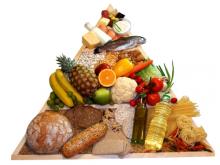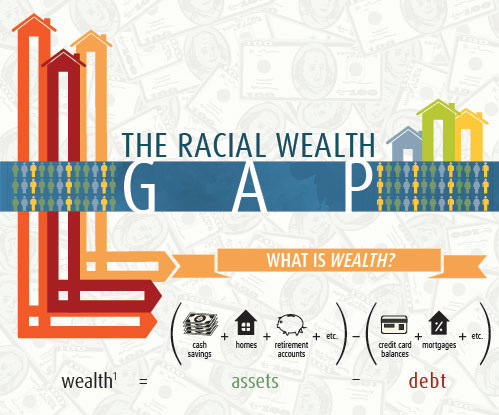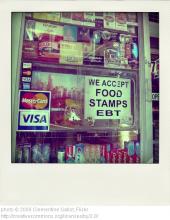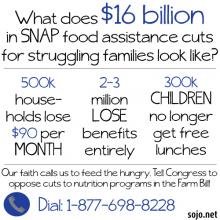SNAP

If you know the facts and faces of the hungry families that are helped by SNAP, I believe it is a moral and even religious problem to vote to cut them. The Bible clearly says that governmental authority includes the protection of the poor in particular, and instructs political rulers to promote their well-being. So the argument that the poor should just be left to churches and private charity is an unbiblical argument. I would be happy to debate that with any of our conservative Congressmen who keep telling our churches that we are the only ones who should care for the poor. To vote against feeding hungry people is un-Christian, un-Jewish, and goes against any moral inclination, religious or
Finally, for politicians to defend these SNAP cuts because of our need to cut spending generally is un-credible and incredible.
These same politicians are not willing to go to where the real money is: the Pentagon budget, which everyone knows to be the most wasteful in government, or the myriad subsidies to corporations, including agribusiness subsides to members of Congress who will be voting to cut SNAP for the poor.
Tea Party-elected Rep. Stephen Fincher, (R-Tenn.), who likes to bolster his anti-poor rhetoric with misused Bible verses, collected $3.5 million in farm subsidies between 1999 and 2012, according to the New York Times. Fincher is helping to lead the effort to cut food stamps to working families with children by illogically quoting: “The one who is unwilling to work should not eat,” all the while collecting millions of dollars in agricultural subsidies. Congressman Fincher's position is hypocritical — and it's this kind of hypocrisy that makes Christians look bad and turns young people away from the church.
You see, for many House conservatives this isn't really about SNAP, but about their opposition to the idea that as a society we have the responsibility to care for each other, even during the hard times or when resources are few. Conservatives know their ideas for privatizing Social Security or cutting funding to Medicare and Medicaid are politically unpopular, but their ideology of individualism that borders on social Darwinism remains unchanged. SNAP is the perfect target for them. The image of what it does and whom it serves has been widely distorted by the media, while the people who benefit from it have little influence in the halls of Congress and pose little risk to the political careers of Republican members.

House leaders are proposing a massive cut to SNAP (Supplemental Nutrition Assistance Program), America’s frontrunner in combatting hunger. This new proposal consists of a $40 billion reduction in funding, and SNAP households across the board would be feeling the pinch beginning as soon as November.
Potential cuts reveal stark and sobering statistics that millions of Americans would face:
- The average benefit per person, per meal would decrease to below $1.40, dangerously low to maintain the minimum standards of a healthy diet;
- 210,000 kids would be cut from free school meals;
- SNAP cuts would be the equivalent of taking away 21 meals per month from a four-person household; and
- 170,000 veterans would lose out on food benefits.

About a year ago, I wrote about my family participating in the Supplemental Nutrition Assistance Program (SNAP) Challenge, which encourages families to try to live on the equivalent of SNAP assistance (food stamps) for one week. It was a growing experience for all of us, and we actually fell short of our intended goal. It turns out that it’s not easy to feed a family of four well — especially without great time and effort — on less than $20 a day.
In looking back on that experience, a number of myths come to mind that I’ve heard from folks about SNAP, which I thought I’d share here.

The acquittal of a person who is not black for the murder or beating of a black person is nothing new: Remember Yusef Hawkins. Remember Rodney King. Remember Amadu Diallo. Remember Alex Moore. Remember Latasha Harlins. Remember Sean Bell. Remember… remember… remember.
Many of us can recall these names without much effort. So, why is the death of Trayvon Martin so different?
It’s different because of the law — and the timing.
The number of those who’ve benefitted from the Supplemental Nutrition Assistance Program (SNAP) has increased nearly seven percent from 8.7 in 2007 to 15.2 in its most recent study. Despite the economic challenges America has faced over the past several years, the Houses’ decision to do away with food stamps has not only caused controversy between the House and the Senate but has caused controversy between the government and the American people. The New York Times reports:
Something terrible has happened to the soul of the Republican Party. We’ve gone beyond bad economic doctrine. We’ve even gone beyond selfishness and special interests. At this point we’re talking about a state of mind that takes positive glee in inflicting further suffering on the already miserable.
Read more here.

A campaign to hold former Pope Benedict XVI responsible for crimes against humanity floundered on Thursday as the International Criminal Court in The Hague threw out a case filed by victims of clergy sex abuse.
The case had been presented in September 2011 by SNAP, the Survivors Network of those Abused by Priests, and the New York-based Center for Constitutional Rights, accusing the pope and other senior Vatican officials of failing to stop abusive priests.
According to a SNAP statement, the court’s prosecutor’s office said on May 31 that the file presented against leaders of the Roman Catholic Church does not meet the “preconditions of the court” and thus “do not appear to fall within the (court’s) jurisdiction.”
 The United States is the richest country in the world, but only three-quarters of Americans have enough to eat.
The United States is the richest country in the world, but only three-quarters of Americans have enough to eat.
New data from the Pew Research Center shows that nearly a quarter of Americans had trouble putting food on the table last year — 24 percent is a lot of hungry people in the richest country in the world. It’s not normal, either – most other advanced economies had much lower rates of hunger. We think that the U.S. economy is similar to that of Canada or Britain; our hunger rate is closer to that of Indonesia, South Korea, or Greece.
Numbers like that are shocking, because we prefer to think of ourselves in nationalistic terms. “The richest, most powerful country on Earth” definitely makes us feel better than realizing that things aren’t so great for many of us. One in four of us is hungry.
We don’t like to think about this, but we aren’t doing so well by a lot of standards. Last month, UNICEF published a report on child wellbeing in developed countries. The United States was ranked 26 out of 29, above Lithuania, Latvia, and Romania. Our children were doing worse than those of Greece.
Is this really where we want to be?

The Farm Bill might not sound like the most exciting piece of legislation ever to come out of Congress, but it has huge implications for nutrition in the United States. Among other things, the Farm Bill determines support to small farms, promoting farmers’ markets, and, oh yeah, the Supplemental Nutrition Assistance Program (SNAP), what we used to call food stamps.
SNAP is one of the most effective anti-poverty programs, set to expand with increased need and decrease when people no longer need help. Most benefits are modest, and the majority of recipients who are able to work do. In fact, SNAP is effective because it not only helps people get the food they need, but its benefits encourage them to find work.
Unfortunately, it seems like both houses in Congress are set on changing the SNAP program for the worse. Putting aside the cuts the House has planned for nutrition assistance that would kick 2 million people off the program, the Senate recently accepted a change to SNAP that flies in the face of the criminal justice system and will probably have racially discriminating effects.
Today a $4 million plan was announced by the U.S. Department of Agriculture. The plan will increase the use of federal food credits at farmers markets by allowing retailers to use wireless technology to connect sellers with the SNAP program. The Washington Post reports:
“These grants increase the availability of fresh fruits and vegetables to SNAP customers and further encourage them to purchase and prepare healthy foods for their families using SNAP benefits,” said Agriculture Undersecretary Kevin Concannon.
Read more here.

The discussion we are having about “the fiscal cliff” is really a debate about our fiscal soul. What kind of nation do we want to be? We do need a path to fiscal sustainability, but will it include all of us — especially the most vulnerable? It’s a foundational moral choice for the country, and one with dramatic domestic and deadly global implications. It is the most important principle for the faith community in this debate.
I had a recent conversation with an influential senator on these fiscal issues. I said to him, “You and I know the dozen or so senators, from both sides of the aisle, who could sit at your conference table here and find a path to fiscal sustainability, right?”
“Yes,” he said, “we could likely name the senators who would be able to do that.” I added, “And they could protect the principle and the policies that defend the poor and vulnerable, couldn’t they?”
“Yes,” he said, “We could do that too.” “But,” I asked, “Wouldn’t then all the special interests come into this room to each protect their own expenditures; and the end result would be poor people being compromised, right?”
The senator looked us in the eyes and said, “That is exactly what will likely happen.”
It will happen unless we have bipartisan agreement, at least by some on both political sides, to protect the poor and vulnerable in these fiscal decisions — over the next several weeks leading up to Christmas and the New Year, and then for the longer process ahead in 2013.
But for that to be viable, the arithmetic must work.

I don’t mind failing as much as I do admitting I’ve failed. And technically, we haven’t blown the SNAP Challenge just yet, but I know for a fact we will by the end of the week.
I went to the store last night for another loaf of bread and a frozen pizza for dinner, which I had promised my kids if they’d make it to mid-week without freaking out. This brought us down to eighteen bucks and change left in the till, which theoretically was going to be enough to fill in the gaps for other items we’d need to do our meals through the weekend.
And then reality hit.

Maybe the serpent in the Garden of Eden story actually was a cute little girl in pigtails. Sure would have been more persuasive than some stupid talking snake.
Explaining to kids who have grown up their entire lives with such privilege is almost like trying to translate a foreign language for them. No, not everyone just goes in and grabs whatever they feel like from the fridge or the shelves. They don’t order in when they’re too tired or lazy to cook, and they don’t mark every mundane occurrence in their lives with a celebratory dinner out. It’s normal to them, but that doesn’t mean it’s normal.

I’m not making friends among my family members with this challenge.
Because it was my idea to do this for a week (living on the equivalent budget of food stamps for seven days), everyone ends up coming to me to “check on the rules.” Basically, this means they ask me about ways they might work around the limitations of the challenge, and then get mad at me when I don’t give them a way out.
Yesterday ended up being a mixed bag. My wife, Amy, and I had to go to the other side of town for some errands, and it didn’t occur to either of us that we’d be gone over lunch time. Fortunately, one of the errands was at an Ikea, a giant housewares store that’s known for it’s affordable cafeteria-style meals, so we made it work. But even with their reduced-rate prices, we spent more than $9 for both of us and little Zoe to eat.
“Man,” I said, looking at my empty bowl, previously filled with pasta and Swedish meatballs, “that was way less than we usually spend going out, but it was still almost double what we have in the budget for one meal.”

“So what are food stamps anyway?” my 8-year-old son, Mattias, asked as I drove him to his summer camp this morning. “Are they, like, stamps that you eat that taste like different foods?”
“Not exactly,” I said.
My family was less than thrilled when I presented the idea of living on the equivalent of what a family of four would receive on food stamps for a week. Actually, the program is now called “SNAP,” which stands for “Supplemental Nutrition Assistance Program,” and involves government-issued vouchers or debit cards, rather than the antiquated stamp method. But the result is the same; we have a lot less to spend on food this week than usual.
“But I don’t want to be poor,” Mattias moaned as I explained the challenge to him.
“We’re not poor,” I said, “but it’s important for us to know what it’s like to struggle to feed our family.”
“Why?”
“Because,” I paused, trying to figure out a way to explain privilege and compassion to a third-grader who was quite content to have all he has, and then some, “Jesus tells us to have a heart for the poor, but how can we really do that if we don’t know anything about what it’s like to live with less?”
“Hmm,” he wrinkled his brow, “I guess we can do it for a few days.”

After putting out there that we’re going to do the SNAP Challenge August 20-26th (living on the budgeted equivalent of food stamps for a week for meals), some folks came forward with some really helpful resources. Even if you’re not on public assistance and not planning to take part in the challenge, these are useful tools to help anyone on a budget plan for some good, nutritious meals.
Here’s a video clip on meal prep with only food bought on the food stamp budget, along with the list of groceries the chef bought on the budget: Mario’s Food Stamp Challenge Grocery List
Here are dozens of recipes from Harvesters Food Network you can do on a food-stamp-equivalent budget, complete with nutrition information for each meal: Harvesters Food Network SNAP Recipes

I’ve said before that privilege often is invisible until you don’t have it. So in that light, I’m doing a little experiment in a few days with our family, and I encourage you to join in.
A lot of us never know what it’s like to try and live below the poverty line, and I tend to think the statements we hear about the poor that lack sensitivity for their situation point to this. It’s easy to say things like, “people on public assistance are lazy” (in fact, 47 percent of SNAP recipients are under 18; a majority of the remaining recipients have other income from work, and this doesn’t account for seniors and those who are disabled) and that food stamps are a “free ride” that are so attractive, it keeps people from wanting to work and get off of the assistance.
So let’s find out just how easy it is.
“SNAP” stands for “Supplemental Nutrition Assistance Program,” which is the new name for food stamps. Basically, families receive $4 a day per family member to cover food costs, so the SNAP challenge is pretty simple (in theory, at least): Live on the same amount with your family for a week.
In an op-ed for Politico, two Representatives highlight the recent cuts to food assistance programs, and the damaging effects they will have on the state of the nation:
The House gutted $16.5 billion from food stamps — our nation’s most important anti-hunger program, which gives low-income families modest aid during tough times. These cuts mean up to three million low-income Americans – largely families with children – can’t buy food.
These cuts in the Supplemental Nutrition Assistance Program also eliminate free school meals for 280,000 children. School breakfast or lunch is too often the only complete meal a child can eat all day. We expect our students to compete in a global economy. We expect them to come to school ready to learn — but we conveniently ignore the facts.
Poor nutrition negatively affects students’ academic achievement. Children who are hungry often miss more days at school and, when they do attend, they may have more trouble concentrating. They often have lower test scores.
Right now, 46 million Americans live in poverty, and more than 32 million adults and 16 million children live in food-insecure households. These families struggle every day to make ends meet — particularly as food prices continue to rise. As more and more families are getting by on less and less, food stamps help make groceries more affordable, so parents have more money to pay the rent, gas up their car and meet their children’s other basic needs. Food stamps kept 4 million Americans over the poverty line in 2010, including 2 million children, and lifted another 1.3 million kids above 50 percent of the poverty line. More than any other benefit program.
Read the full article here

A common rationalization those in religious circles make for cutting social programs that help the poor is that church should be the one helping “the least of these,” not the government. But if we know that’s not possible given the church’s means, that millions will get left behind because our efforts fall far too short, is that still a logical line of defense? Jesus told us to care for the poor, sick, and vulnerable—he didn’t prescribe how.
Sometimes Jesus healed people one-on-one. Sometimes he addressed the needs of a multitude by providing enough food to feed them all. Sometimes he sent others in his stead to provide healing.
If we ignore the needy in our midst by getting rid of one huge way to address that need, we are not following Jesus’ example.

Editor's Note: On Wednesday, the House Agriculture Committee voted to slash $16.5 billion in nutrition assistance funding in the farm bill. Rep. James McGovern led efforts to stop the drastic cuts to anti-hunger programs. He offers his thoughts to Sojourners on the committee decision.
I am disappointed that a majority of the House Agriculture Committee voted against my amendment to eliminate the $16.5 billion in cuts to the Supplemental Nutrition Assistance Program, or SNAP, included in the Farm Bill. These cuts are detrimental, cruel, and immoral. They literally take food away from hungry people; people who are poor; people who struggle to feed their families. SNAP is the most effective and efficient federal program. Let me repeat that – the most effective and efficient program. In fact, the error rate was 3.81 % in 2010, the lowest in the history of the program. And that rate continues to decrease.
It is false to say that these cuts won’t affect benefits or that they are merely closing loopholes. They will result in less food for hungry, low-income Americans – period.

Religion reporter Amy Sullivan has an interesting piece in The New Republic today on the politics surround the deep cuts to government food programs being proposed by the House Agriculture Committee.
As she notes:
"Some conservatives have argued that government shouldn’t even be in the business of feeding people—that the job should be handled by local congregations and other community organizations. Paul Ryan has sparred with Catholic bishops who oppose cuts to SNAP, quipping that 'a preferential option for the poor does not mean a preferential option for big government.'”
The article goes on to note that, while churches were the only social safety net the country had for many years, it was the Great Depression which ended this role. Quoting from an article by Alison Collis Greene:
“'The Depression crippled churches’ finances, and the economic downturn forced them to slash services when people needed help most. Religious leaders and local church members alike recognized the crisis, and many demanded that the federal government intervene.'”
Sullivan argues that we find ourselves in a situation not so different to that of the 1930s today:
"We are watching a similar situation play out now. Many religious traditions and individual churches were struggling when the recession began. The Catholic church was dealing with the fallout from the priest sex abuse scandals. It and other traditions are still embroiled in debates over homosexuality that have led to splits or caused members to leave altogether. Congregational membership levels are down in almost every religious tradition. And as a result, their resource pools have shrunk."
Yes, smarter and more effective government programs are vital when budgets are being cut across the board. But indiscriminate cuts to vital services like the Supplemental Nutrition Assistance Program (SNAP) and calls for churches to pick up the pieces are simply immoral and ultimately impossible.
The cuts being proposed by the Committee will have a devastating impact on poor Americans. It’s time to stand up for the poorest and more vulnerable. You can help. Tell Congress to oppose cuts to nutrition programs in the Farm Bill today.